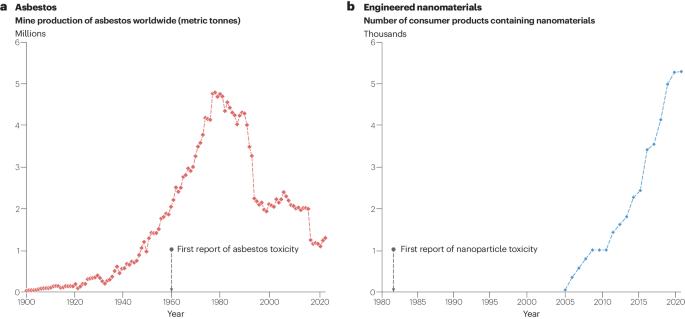Trends, risks and opportunities in environmental nanotechnology
引用次数: 0
Abstract
Engineered nanomaterials (ENMs), intentionally synthesized materials with sizes less than 100 nm in at least one dimension, have numerous potential environmental applications, such as pollution remediation and water treatment. However, concerns regarding their potential health and environmental impacts have been raised. In this Review, we assess the opportunities of ENMs in environmental applications versus their potential public and environmental health risks, focusing on water treatment and reuse, and identify strategies for their responsible use. Life-cycle analyses indicate that the highest potential environmental and health impacts of ENMs used in commercial products are associated with production rather than incidental release during use. Typically, the detected or predicted ENM concentrations are 1 to 4 orders of magnitude lower than their respective predicted no-effect concentrations. In addition, ENMs often undergo passivating transformations, such as agglomeration and oxidation, reducing risks after release. Therefore, the environmental and health risks of ENMs are relatively low. However, some point sources under extreme scenarios, such as sewage effluent, can potentially increase localized risks. Adopting green chemistry and immobilization strategies can further limit the release of ENMs, minimizing their potential discharge into the environment. Such strategies to reduce toxicity and exposure enable sustainable application of ENMs, such that the environmental benefits could outweigh the risks if managed properly. Engineered nanomaterials (ENMs) have numerous environmental applications, such as in water treatment and reuse. This Review explores the trade-offs between the risks and benefits of environmental ENMs, and highlights that the environmental and health risks of ENMs are relatively low when used responsibly.


环境纳米技术的趋势、风险和机遇
工程纳米材料(ENMs)是一种有意合成的材料,至少在一个维度上的尺寸小于 100 纳米,具有许多潜在的环境应用,如污染修复和水处理。然而,人们也对其潜在的健康和环境影响表示担忧。在本综述中,我们以水处理和再利用为重点,评估了 ENMs 在环境应用中的机遇与其潜在的公共和环境健康风险,并确定了负责任地使用 ENMs 的策略。生命周期分析表明,商业产品中使用的 ENMs 对环境和健康的潜在影响最大的是生产过程,而不是使用过程中的偶然释放。通常情况下,检测到或预测到的 ENM 浓度比各自预测的无效应浓度低 1 到 4 个数量级。此外,ENM 通常会发生钝化转化,如结块和氧化,从而降低释放后的风险。因此,ENMs 的环境和健康风险相对较低。不过,在极端情况下,一些点源(如污水)可能会增加局部风险。采用绿色化学和固定化策略可以进一步限制 ENMs 的释放,最大限度地减少其向环境排放的可能性。这种减少毒性和接触的策略能够实现 ENM 的可持续应用,因此,如果管理得当,环境效益可能会大于风险。
本文章由计算机程序翻译,如有差异,请以英文原文为准。
求助全文
约1分钟内获得全文
求助全文

 求助内容:
求助内容: 应助结果提醒方式:
应助结果提醒方式:


